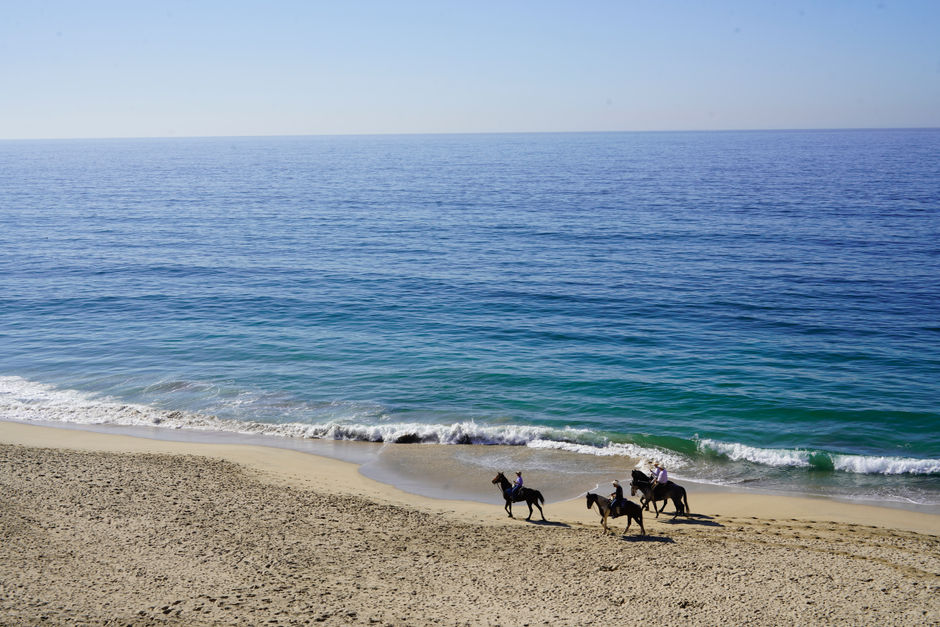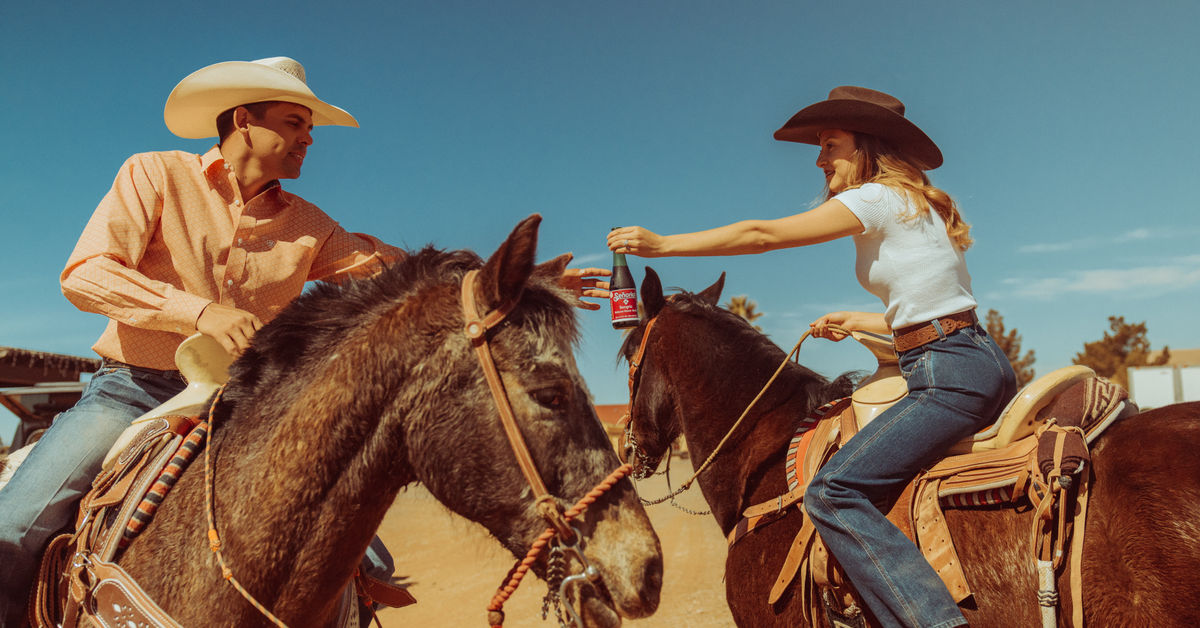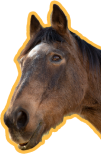Introduction to Horses
Horses aren’t your typical animal–not even close! These strong, elegant, and loyal creatures are some of the most intelligent animals on the planet, making them the perfect companions for humans. But horses require respect and care. Good riders treat their horses as part of the family or even extensions of themselves. Neglecting the animals or not providing appropriate care will damage not only the animals’ health but also your relationship with them.
Here are some important things to know about horses:
- Horses are big–they can be 1.4 to 1.8 meters tall and weigh more than 350 kilos!
- Each horse has its own personality.
- Horses have incredible memories, can recognize faces, and learn new things very quickly.
- Horses are herd animals, which means they are social and have hierarchies in their communities.
- Horses can read moods and pick up clues through body language.
- Every breed of horse is athletic.
- Horses have unique eyes that give them incredible peripheral and binocular vision.
The more time you spend with horses, the more you’ll understand all the little and big aspects that make them such wonderful animals. So, as you begin your journey as an equestrian, know that you’ll never be alone, as your horse will be with you every step of the way.
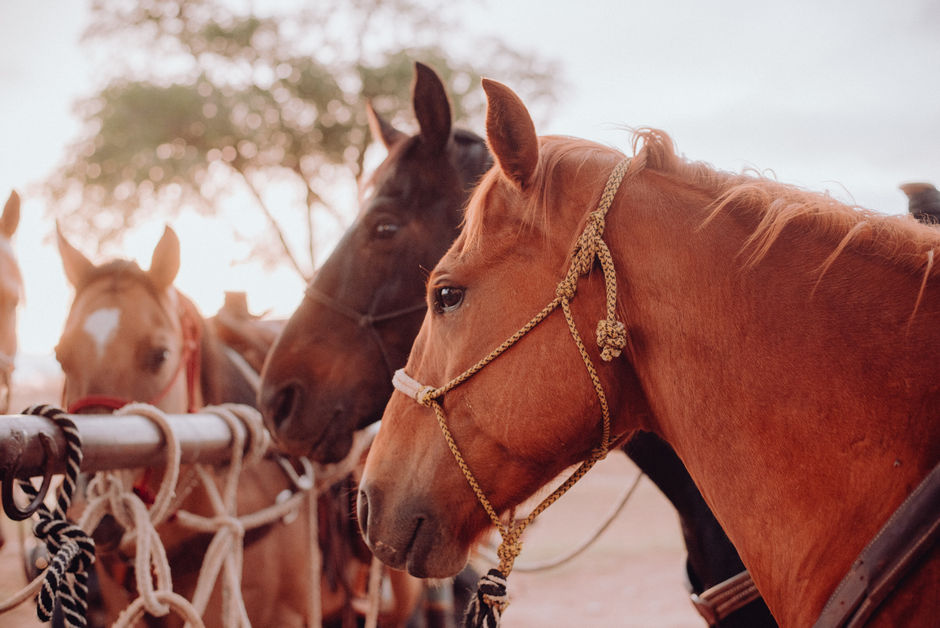
Equipment and Gear
Becoming a horse rider means you need to invest in the appropriate gear and equipment. There’s an endless catalog of items you could buy, but we’re going to highlight the things you need! When it comes to the gear you purchase, do your research and seek advice from other riders before making a purchase. Poor quality equipment could put you and your horse at risk and hinder the riding experience.
Equipment for Riders
- Helmet
- Helmets are critical. Horses are tall creatures that move very fast. Accidents do happen, and if you fall off a horse, not wearing a helmet can lead to serious injuries. Don’t risk your health and wear a helmet.
- Boots
- All equestrians should have a good pair of riding boots. These specialized boots have specific features to enhance the riding experience and keep you safe. These features include a protective toe box to prevent toe injuries and slight heels and textured soles to prevent your feet from slipping out of the stirrups. Regular walking boots will not provide the same benefits.
- Riding Pants
- Riders have a range of options when it comes to riding pants. The most popular styles are snug but breathable jeans, breeches, or simply a pair of leggings. Breeches may be required if you plan to ride in a formal contest. But, for the most part, pants should be anything you’ll be comfortable wearing while riding for multiple hours.
- Safety Vest
- A safety vest isn’t mandatory for riders, but it’s recommended. These vests provide padding for the torso area to reduce the chance of injury in case of a fall or being kicked by hooves. Vests come in all types of designs, and most of them are comfortable and breathable.
- Gloves
- Using your hands is a big part of riding. Gloves will ensure you have a strong grip no matter how slick your palms or the reins are. However, a bad-fitting pair of gloves can make handling the reins even harder, so make sure to find the right fit.
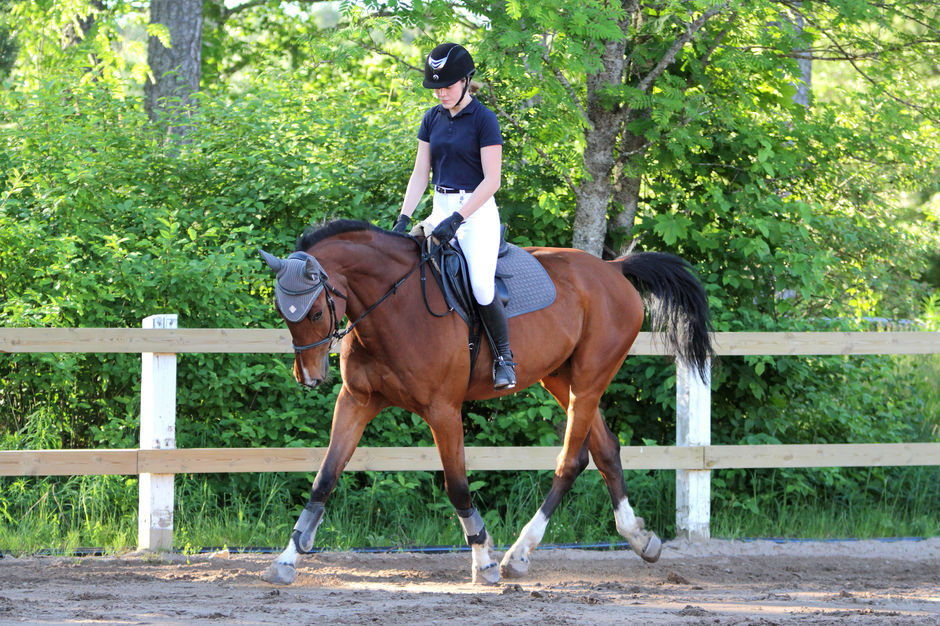
Equipment for Horses
- Saddle, Saddle Pad, and Girth
- Saddles keep both riders and horses safe and comfortable. That means the one you choose needs to not only be a good fit for you but also your horse. In addition, you need a saddle pad (also referred to as a saddle blanket), which is a piece of fabric that prevents the saddle from irritating the horse’s skin. Lastly, the girth is the band that goes around the belly of the horse and attaches to either side of the saddle.
- Bridle, Reins, and Bits
- Bridles and reins help you communicate with your horse. The bridle attaches to the animal’s head and connects to the bit, which is a piece that stretches across the mouth. A pair of reins then attaches to the bit, allowing you to make tugging gestures to communicate with the horse.
- Stirrup Irons and Leathers
- Stirrup irons are where you place your feet when sitting on top of the horse. The stirrup leathers are bands that attach the irons to the saddle. These bands can be adjusted for maximum comfort while riding.
- Grooming and Bathing Kits
- Taking proper care of your horse needs to be a top priority. Grooming your horse will keep it happy and healthy, and you’ll be able to check for any concerning symptoms that may need medical attention. Oh, and grooming is an excellent bonding opportunity!
- Fly Spray
- Flies and horses, unfortunately, are a package deal. The annoying insects are attracted to horses’ eyes, and it’s very important to have fly spray to protect your horse. Flies can carry diseases and just make life more uncomfortable for your animal. Keep in mind that fly spray won’t eliminate the problem, but it will help.
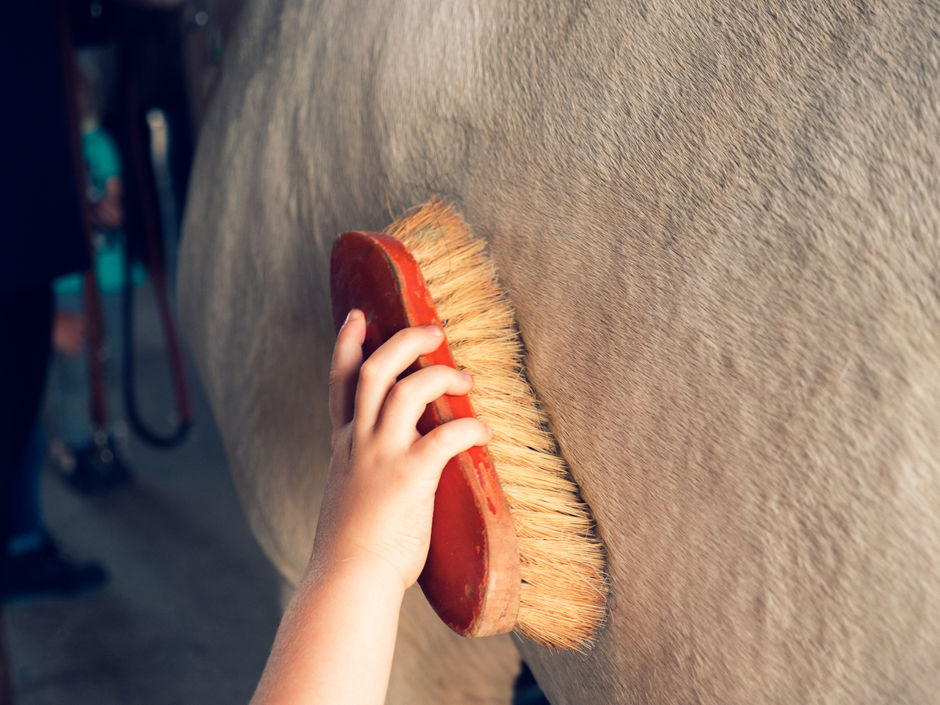
Basic Riding Techniques
Horse riding takes practice, and there are a lot of little details you will begin to master over the years. However, there are a few basic riding techniques that will act as your foundation. Learning these techniques will help you avoid horse riding mistakes and ensure you understand the fundamentals of the activity. So, let’s take a look at five horse riding tips that are just as important for beginners as they are for experts.
1. Greet Your Horse
Good horsemanship starts before getting on the saddle. Greeting your horse and checking their mood will always be step one, no matter if you’ve owned your horse for one day or several years. Horses are big, powerful animals that have to be respected and not treated like inanimate objects. Failing to make the horse comfortable before hopping on the saddle could lead to accidents. So, practice your greeting techniques and ability to read their moods.
2. Keep a Straight and Centered Body Position
Balance is everything, and the way you sit determines how secure you’ll be while riding. Proper body position means sitting up straight and centered in the saddle. You want to keep your body erect while maintaining a relaxed back. You may feel a bit uncomfortable at first, but as you develop core muscles and better balance, it will be as easy as one-two-three.
3. Keep Heels Down
Foot positioning is just as important as sitting up straight and centered. While you ride, put your weight into your heels. Keeping your heels down is a common riding technique, but that doesn’t mean you have to forcefully shove your heels into a downward position. Instead, find a position that lets you naturally shift your weight to your heels. This will allow you to sit down more comfortably and securely.
4. Look in Front of You
When you’re first learning to ride a horse, you’ll be tempted to look down at the animal or the reins. However, it’s imperative that you keep your eyes up and focused on what’s in front of you. Looking down negatively impacts your posture, making you less balanced for incoming turns and bumps. Additionally, you need to be aware of anything on the trail that may startle your horse, causing it to rear or make sudden movements.
5. Gently Handle the Reins
Learning the proper techniques to handle the reins takes time. You want to hold them with a firm but relaxed grip. If your hands are tensed, then you need to ease your hold. Also, you should not yank the reins with excessive force. This can be very uncomfortable for the animal and cause it to rear or stop responding to commands.
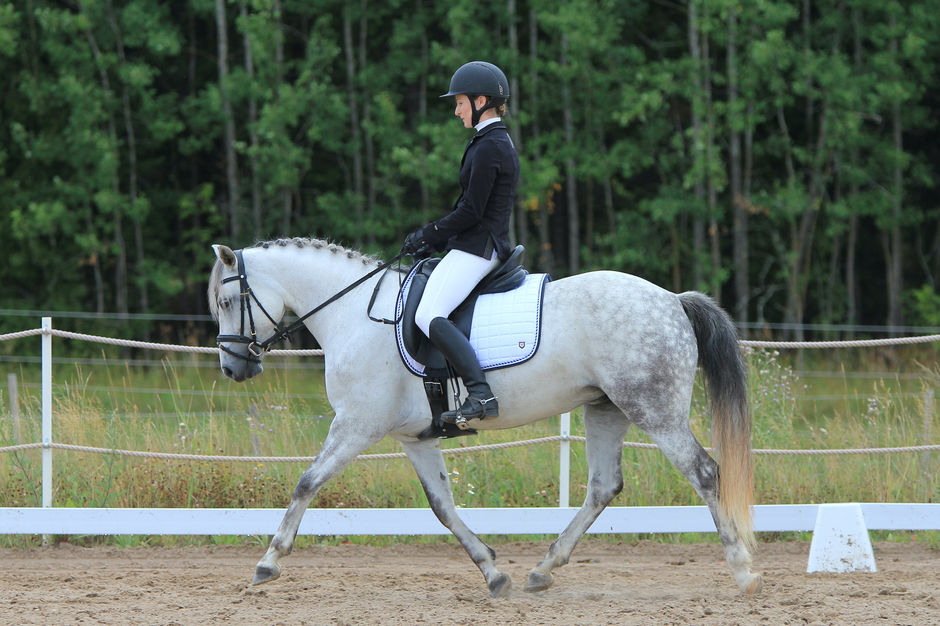
Mounting and Dismounting
If you’ve never mounted or dismounted a horse, don’t worry! Both processes only take a few simple steps, and you’ll master them in no time. One key thing to remember is to move slowly and confidently. Quick, reckless movements can startle the horse, and we don’t want that to happen. So, look where you place your hands and feet and hoist yourself on or off the horse once you are in a secure position.
Steps to Mounting a Horse
- Check that the saddle is properly attached.
- Approach the horse on the left side (mounting from the left side has been common for hundreds of years and helps communicate with the horse that you are preparing to mount).
- Place both reins in your left hand.
- Insert your left foot into the stirrup (place the ball of your foot on the metal).
- Jump off your right foot, push down with your left foot, and swing your right leg to the other side of the saddle (be mindful not to kick the horse).
- Gently position yourself on the saddle.
- Insert your right foot into the stirrup (place the ball of your foot on the metal).
Easy, right? Now let’s go over the proper way to dismount the horse.
Steps to Dismounting a Horse
- Come to a full stop and check if there are other horses nearby.
- Place both reins in your left hand.
- Remove your feet from the stirrups.
- Lean forward and swing your right leg to the other side (be mindful not to kick the horse).
- Slowly slide off the horse’s back and lower your feet to the ground.
With a little practice, mounting and dismounting a horse will become second nature. Just remember to take your time and be careful not to aggressively yank or kick the horse.
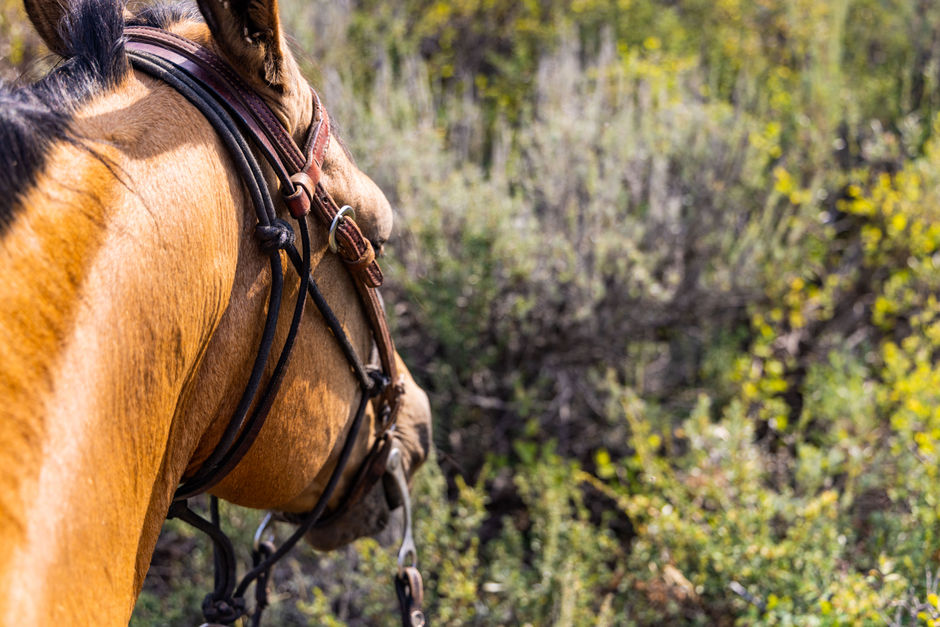
Walk, Trot, Canter, and Stop
All horses have four basic gaits (strides): the walk, trot, canter, and gallop. Because this guide is for beginner horseback riders, we’re going to focus on the walk, trot, and canter. We’ll also look at how to stop a horse safely and effectively.
Know that as the horse gains more speed, it will become a bit more difficult to remain balanced. So, take it slow and listen to your instructor for advice.
How to Ride at a Walk
- Once you’ve mounted your horse and positioned yourself on the saddle correctly, it’s time to get the horse to walk.
- Check your posture and the positioning of your feet in the stirrups.
- Keep a firm but light grip on the reins (be careful not to pull back on the reins when you want to go forward).
- Lightly squeeze the horse with your lower legs. This will direct the animal to begin walking.
- If the horse is not responding, you can gently bump its sides using your heels (some horses respond better than others).
- Keep your eyes focused on where you are going.
- Enjoy the ride!
How to Ride at a Trot
If you feel comfortable riding at a walk, it’s time to level up to a trot. Trotting will be a bit bouncier and faster, but the important thing is to focus on your posture and stay calm. The best way to practice is to start with short trots and work your way up to longer trotting sessions.
- Just like when you signaled the horse to walk, lightly squeeze your legs to prompt your horse to trot (you may have to give the horse a few light bumps with your heels).
- Adjust your position to remain balanced as the horse bounces up and down. You can use the grab strap or the horn of the saddle in case you feel unsteady (try to move with the motion of the horse).
- Keep your legs relaxed and avoid squeezing the horse.
- Avoid pulling back on the reins to prevent hurting the horse’s mouth.
- Keep your eyes focused on where you are going.
How to Ride at a Canter
A canter is a three-beat gait that’s slightly slower than a four-beat gallop. However, it’s important to note that gaits are not determined by speed; rather, they are determined by the timing and pattern of the horse’s footfalls. Although a canter is usually faster than a trot, you do not want to simply increase speed to begin cantering. Instead, you want to rely on a signal to communicate with your horse to change gaits.
- Signal your horse to begin trotting.
- While trotting, use the signal your horse associates with cantering. Most horses will begin cantering if you slide your outside (left) leg back and lightly squeeze with both legs (other horses may respond to a click or kissing noise).
- Stay centered on the saddle.
- Move your hips with the horse’s motion to avoid bouncing.
- Keep your eyes focused on where you are going and avoid tugging the reins.
- To slow down, pulling on the reins will gesture to your horse to go back to a trot.
How to Stop a Horse
When it’s time to stop, you want the transition to be gentle for both you and the horse. Avoid aggressively yanking on the reins to signal a stop, which could be painful for the animal. Practice coming to a complete stop from a slow walk, and gradually work your way up to faster gaits.
- Check your posture.
- Instead of moving your hips with the horse, tighten your abdominal muscles and push your tailbone into the seat.
- Tense your legs against the horse’s body. You don’t want to press too hard, and once the horse begins slowing, you can release the tension.
- Gently pull the reins back (some horses will respond to verbal gestures, so ask your instructor).
- Come to a stop.
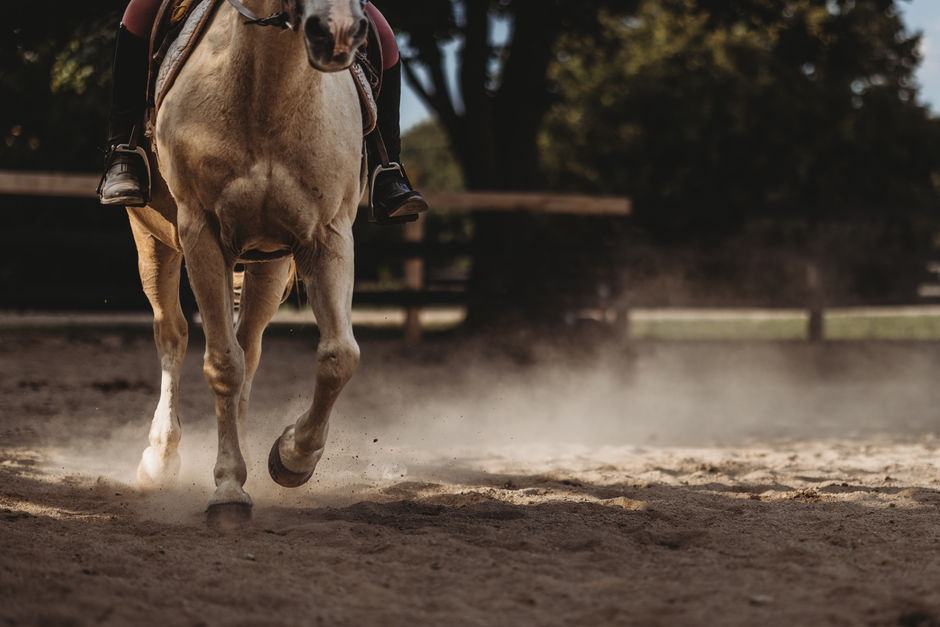
Turning Left and Right
So, now that you know how to walk, trot, canter, and stop, let’s talk about how to turn. Turning is an important skill that requires balance and proper communication with the horse. There are two ways to turn, either by using the reins or your legs. Start by practicing one method before moving on to the other.
Turning with the Reins
- Signal your horse to begin walking.
- Hold both reins with even pressure.
- Turn your head in the direction you want to turn (horses can pick up body signals).
- Then, release your pressure on the outside rein to direct your horse to turn in the direction of the inside rein (for example, if you wanted to turn right, you would release the tension on the left rein).
- Be careful to keep consistent tension on the reins throughout the turn.
- Once the turn is complete, put equal tension on both reins.
Turning with Your Legs
- Ride while applying equal pressure with both legs.
- Release pressure on the inside leg to signal the horse to turn to the inside (for example, if you want to turn right, release the pressure of your right leg).
- Apply a bit more pressure with your outside leg to continue signaling the turn.
- Once the turn is complete, return to a regular position and apply equal pressure with your legs.
Safety Tips
Safety needs to be your number one priority when you become an equestrian. Horses are beautiful animals, but if you don’t take the proper precautions, you could get seriously injured. Here are a few tips to ensure you have a safe and enjoyable experience.
- Wear a helmet (a safety vest is recommended).
- Start slow and build confidence.
- Take Lessons with a proper trainer.
- Choose the right horse.
- Purchase reliable equipment.
- Listen to the horse and respond to its moods appropriately.
Book an Unforgettable Riding Tour
Riding a horse is an incredible experience that not everyone gets to have. As a beginner horseback rider, you have a lot to look forward to. If you’re interested in starting your equestrian journey by going on an unforgettable horseback riding tour, then take a look at our catalog! Horse Tours Club connects riders with the best multiday tours across the world for no additional markup. Your professional guides will show you how to ride a horse and ensure that you have everything you need for the trip of a lifetime!
